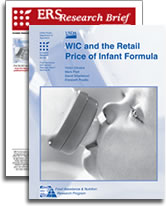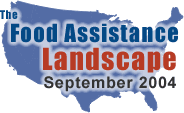|
|
||
| a healthy, well-nourished population | ||
|
overview
features
The U.S. Food Marketing System, 2002—This report focuses on recent trends in the food supply chain. Chapters on food manufacturing, wholesaling, grocery retailing, and food service provide a detailed overview of structure, performance, information systems, new technology, and foreign direct investments. The report also contains a comprehensive set of appendix tables containing sales, concentration, trade, productivity, and other indicators. Also see related data on Food Market Indicators.
recommended readings Issues in Food Assistance—The Issues in Food Assistance series, part of ERS's Food Assistance and Nutrition Research Program, addresses a variety of topics related to the USDA food assistance programs. Issues briefs currently available cover changes in the Child and Adult Care Food Program, food insecurity, and the standard deduction in the food stamp benefit formula. Upcoming briefs will cover such topics as low-income rural Americans, private food aid (food pantries, food kitchens, etc.), low-income families, unemployment, the U.S. economy, and self-sufficiency among former food assistance receivers. America's Eating Habits: Changes and Consequences—This compendium provides different perspectives on nutrition problems in the United States. Healthier diets might prevent $71 billion per year in medical costs, lost productivity, and the cost of premature deaths associated with these conditions. See all recommended readings... recommended data products Food Consumption (Per Capita) Data System—ERS annually calculates the amount of food available for human consumption in the United States. This series tracks historical national aggregate consumption of several hundred basic commodities. It is the only continuous source of data on food and nutrient availability in the United States and provides data back to 1909 for many commodities. See also the related report, Food Consumption, Prices, and Expenditures, 1970-97. Current Population Survey (CPS) Food Security Supplement Data—The CPS-FSS is the source of national and State-level statistics on food insecurity and hunger used in USDA's annual reports on household food security. National data useful in food and nutrition assistance research—Brief descriptions of national surveys and data sets with links to the sponsoring organizations. recent
research developments Food Assistance and Nutrition Research Program, Final Report: Fiscal 2003 Activities—Provides an overview of FANRP's research themes, principles, and activities and describes the objectives of individual research projects. A list of FANRP's Competitive Grants and Cooperative Agreements Program awards in fiscal 2003 and project descriptions are also available. Benefits of Proposed Nutrition Labeling Rule Estimated—USDA's Food Safety and Inspection Service has proposed requiring that nutrition information be provided for fresh meat and poultry products. This information could be provided by including a "Nutrition Facts" label like those now placed on processed food products. According to ERS estimates, changes in consumer behavior in response to the nutrition information could lead to healthier food choices, thereby reducing medical costs, productivity losses, and premature death from diet-related diseases, such as stroke, coronary artery disease, or cancer. ERS estimates that the benefits associated with these diet-related health improvements could be as much as $145 million per year. related links Food and Nutrition Service—The agency responsible for administering the Nation's food and nutrition assistance programs. Food and Nutrition Information Center (FNIC)—One of several information centers at USDA's National Agricultural Library. Access all of FNIC's resource lists and databases, as well as many other food- and nutrition-related links. Center for Nutrition Policy and Promotion—The focal point within USDA where scientific research is linked with the nutritional needs of the American public. National Research Initiative Competitive Grants Program—The office in the Cooperative State Research, Education, and Extension Service (CSREES) of USDA charged with funding research in biological, environmental, physical, and social sciences relevant to agriculture, food, and the environment.
for more information, contact:
James Blaylock |
|||||||||||
|
|
USDA / FedStats / accessibility / privacy policy / contact us / advanced search / site map |
 Improved nutrition has been a key goal of all modern societies. Sound
nutrition frees a nation and its people to pursue goals that improve the
human condition. A healthy and well-nourished population is more productive
and able to focus its energies on the provision of goods and services
associated with a highly developed society. In 1900, households relied
primarily on local food production, and the predominant nutritional problems
were low caloric intake and inadequate intakes of certain vitamins and
minerals. Today, a hallmark of the American agricultural system is that
consumers enjoy year-round abundance of nutritious and affordable foods.
With prosperity, however, comes new challenges.
Improved nutrition has been a key goal of all modern societies. Sound
nutrition frees a nation and its people to pursue goals that improve the
human condition. A healthy and well-nourished population is more productive
and able to focus its energies on the provision of goods and services
associated with a highly developed society. In 1900, households relied
primarily on local food production, and the predominant nutritional problems
were low caloric intake and inadequate intakes of certain vitamins and
minerals. Today, a hallmark of the American agricultural system is that
consumers enjoy year-round abundance of nutritious and affordable foods.
With prosperity, however, comes new challenges.  FANRP 2004 Awards
FANRP 2004 Awards

 The
Food Assistance Landscape
The
Food Assistance Landscape Food and Eating Consequences of Time-Use Decisions: A Research and Policy Conference
Food and Eating Consequences of Time-Use Decisions: A Research and Policy Conference